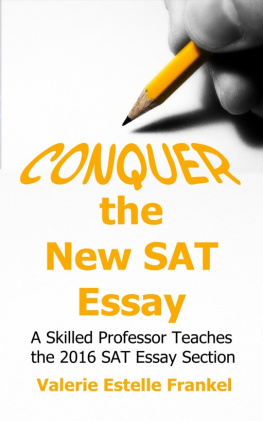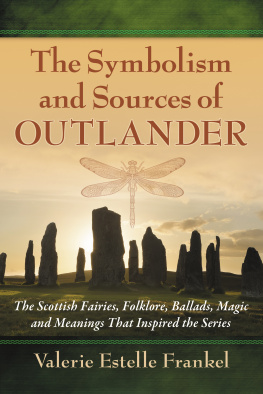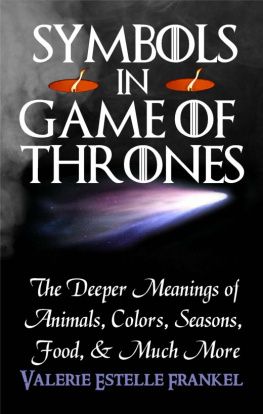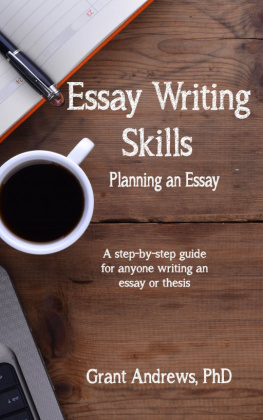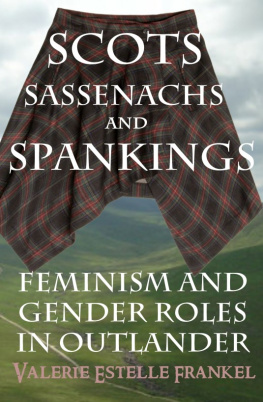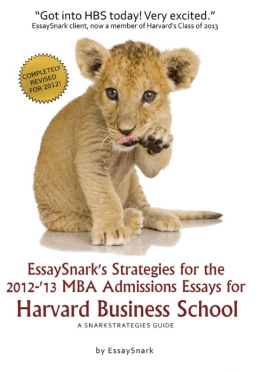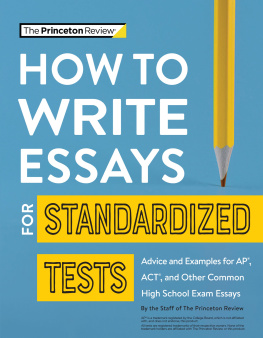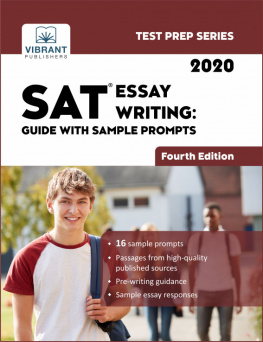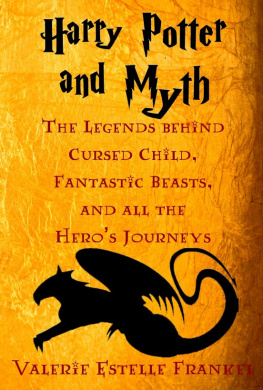Conquer the New SAT Essay: A SkilledProfessor Teaches the 2016 SAT Essay Section
Valerie Estelle Frankel
Copyright 2016 Valerie Estelle Frankel
Smashwords Edition
Other Works by Valerie Estelle Frankel
Henry Potty and the PetRock: A Harry Potter Parody
Henry Potty and theDeathly Paper Shortage: A Harry Potter Parody
Buffy and the Heroines Journey
From Girl to Goddess: The Heroines Journeyin Myth and Legend
Katniss the Cattail: The Unauthorized Guideto Name and Symbols
The Many Faces of Katniss Everdeen: TheHeroine of The Hunger Games
Harry Potter, Still Recruiting: A Look atHarry Potter Fandom
Teaching with Harry Potter
An Unexpected Parody: The Spoof of TheHobbit Movie
Teaching with Harry Potter
Myths and Motifs in The MortalInstruments
Winning the Game ofThrones : The Host of Characters &their Agendas
Winter is Coming: Symbols & Portents inA Game of Thrones
Bloodsuckers on the Bayou: The Myths andTales Behind HBOs True Blood
The Girls Guide to the HeroinesJourney
Choosing to be Insurgent orAllegiant: Symbols, Themes & Analysis of the DivergentTrilogy
Doctor Who and the Heros Journey:The Doctor and Companions as Chosen Ones
Doctor Who: The What Where andHow
Sherlock: Every Canon ReferenceYou May Have Missed in BBCs Series
Symbols in Game ofThrones
How Game of Thrones WillEnd
Joss Whedons Names
Pop Culture in theWhedonverse
Women in Game ofThrones : Power, Conformity, andResistance
History, Homages and theHighlands: An Outlander Guide
The Catch-UpGuide to Doctor Who
Remember AllTheir Faces: A Deeper Look at Character,Gender and the Prison World of Orange Is The NewBlack
Everything ILearned in Life I Know from Joss Whedon
Empowered: Symbolism, Feminism,and Superheroism of Wonder Woman
The Avengers Face their DarkSides
The Comics of Joss Whedon:Critical Essays
Mythology in Game ofThrones
Were Home: Fandom, Fun, andHidden Homages in Star Wars: The Force Awakens
A Rey of Hope: Feminism, Symbolismand Hidden Gems in Star Wars: The Force Awakens
Introduction
As a university English instructor and SATskills tutor in the San Francisco Bay Area a high-pressureacademic area near Stanford I understand the stress andimportance of the SAT, which can determine students futures. Nowin 2016 its changing once more. The vocabulary has been cut,replaced by reading passages that ask how this word is used (notits dictionary meaning) and what evidence from the passage showsthis. Basically, reading lots of fun novels or doing lots ofpractice problems are the best way to improve skills in this area.Theres a redesigned writing section, now with short essays filledwith errors. Many of these are grammar (subject-verb agreement,colons and semicolons, verb tense, pronouns, and so on), whileothers deal with essay organization each paragraph must make asingle point, support the thesis, and so forth. There are twolevels of math sections too. However, this book doesnt teach anyof these but focuses specifically on one of the biggest changes the essay.
The new SAT includes a 50 minute essay optional, but many colleges require it for admissions. This bookexplains how to master it, with 50 practice passages and 30 pagesof instruction.
The book begins by explaining the question andscoring guide, along with how to read the passages, budget time,annotate, and finally construct a clear essay.
A large part of this book is rhetoricaldevices metaphor and simile, yes, but also more unusual ones. Yousound more educated and precise saying The author uses anaphorarather than The author starts multiple sentences the same way.Diction, syntax, tone, point of view, and all the special nuancesof these are explained clearly, along with much new vocabulary tohelp you present ideas clearly. Of course, as this book explainsirony, symbolism, allegory, and many terms from high school Englishclass, it can help readers improve there as well.
Part III takes this a step further termsonly taught at a higher level of education, less required for theSAT and more sophisticated, for those who would like to give theiressays additional polish. It contains links to even more rhetoricaldevices to aid study.
The last section offers 50 original sampleprompts, taken from classic literature and historical writingsinstead of existing textbooks. The first five are followed bysample essays and the next fifteen have a list of sample thesisstatements one might use to explicate these passages. The passagesare of course intended for individual practice necessary in orderto excel.
There are several ways to use this book.Certainly, a tutor might use it as an in-class text. At home, astudent or group of students might practice with it. The beststrategy is to write practice essays, and then perhaps discusstheir strengths and weaknesses with a peer, parent, or teacher. Thereal grading rubric is included. Lacking time for writing practiceessays, at least writing thesis statements and short outlines,defining how one could write the essays, is a valuablepractice activity. My own students preferred to do this open book looking up the literary devices in order to practice using themcorrectly. The best way to prepare is really practicing writingmany essays and outlines, using the new rhetorical terms, so thatthe real passage on the SAT will be no trouble at all.
Part I:Understanding the New SAT Essay
Overall Changes
* The essay is now 50 minutes long instead of25 minutes.
* Now instead of agreeing or disagreeing withan open-ended question and providing outside evidence, you mustanalyze a passage written by an author who is taking a stance on anissue. Specifically, you dont take your own stance on the issuebut instead analyze how the author builds theargument.understanding how evidence and rhetorical devicescontribute to an argument is central.
* The essay is scored on a scale of 1-4 (bytwo readers for a total out of 8) in the areas of Reading,Analysis, and Writing. This score is not combined with the Readingand Writing section score of 800.
The new SAT essay is much more analytical andargument focused. These are the new instructions:
As you read the passage below, consider how[the author] uses
* evidence, such as facts or examples, tosupport claims.
* reasoning to develop ideas and to connectclaims and evidence.
* stylistic or persuasive elements, such asword choice or appeals to emotion, to add power to the ideasexpressed
Following this comes the passage. After, thequestion is phrased like this:
Write an essay in which you explain how [theauthor] builds an argument to persuade [his/her] audience that[authors claim]. In your essay, analyze how [the author] uses oneor more of the features listed above (or features of your ownchoice) to strengthen the logic and persuasiveness of [his/her]argument. Be sure that your analysis focuses on the most relevantfeatures of the passage. Your essay should not explain whether youagree with [the authors] claims, but rather explain how the authorbuilds an argument to persuade [his/her] audience.
Heres a sample:

College Board adds that all passages havethese things in common:
* Written for a broad audience
* Argue a point
* Express subtle views on complexsubjects
* Use logical reasoning and evidence tosupport claims
* Examine ideas, debates, or trends in thearts and sciences, or civic, cultural, or political life

